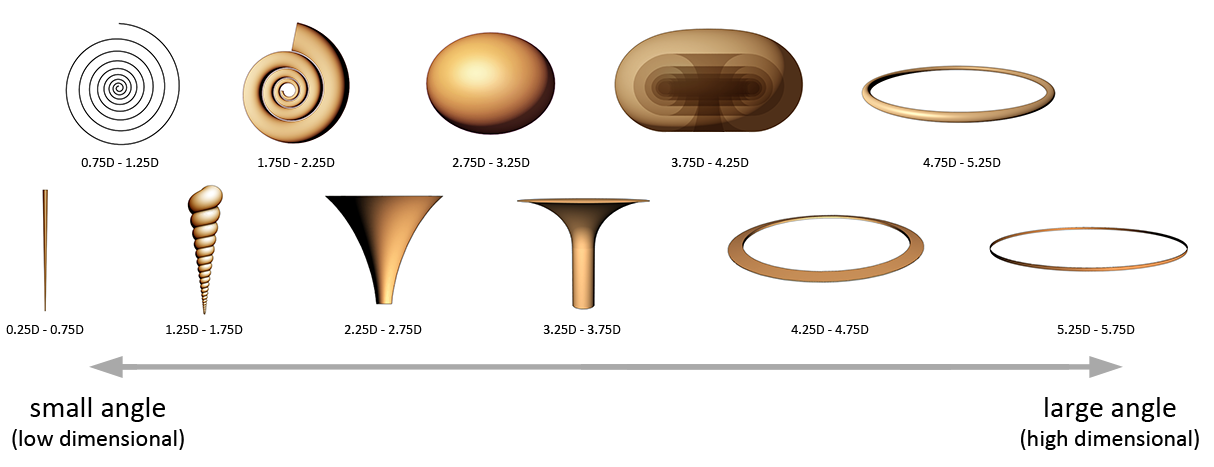Waves and Dimensions
We've seen on the previous page how multiple vortex types can connect into one great puzzle, yet we now need to explain so to how and why this happens. The logical order in which the vortices connect has to do with dimensions, which is an essential link between two phenomena that will be explained on this page. To explain what these vortices are and what their relation is to dimensions, we need to take a look at another phenomenon that is closely linked to these vortices. We need to start off by looking at waves.
Overlapping Waves
All sorts of waves are crossing the space around us as we sit at home behind our computer, or walk outside on the street. Light is all around us, and sound is all around us, both coming in from all different directions. Cosmic background radiation is all around us. And in this modern age of radio, WiFi, mobile phones and remote controls, the number of electromagnetic waves has steadily increased within the developing world that we live in.
But have you ever tempted to ask yourself this simple question: if there are so many wave signals crossing the space around us, then how come a majority of those wave signals do not bump into each other? We know that there are many radio channels that broadcast their signals at different frequencies. All those different signals cross the same space, and we can catch all those different signals with a single radio-receiver, without having to move the receiver to a different spot to catch a different channel. These waves all overlap, yet if the frequencies are far enough apart, then one broadcast does not interfere with the other.
The same applies to infrasonic sound waves, which are spherical outgoing waves that are not affected by radio waves. And when the frequencies of these infrasonic sound waves are not too close to one another, then two different infrasonic sound waves do not bump into each other.
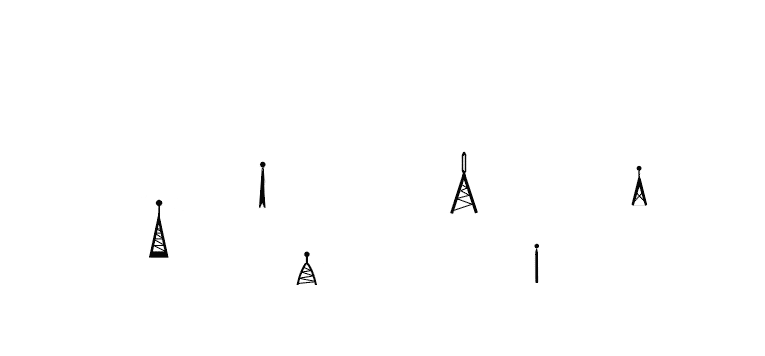
And there's more. Many of these outgoing waves can travel through solid objects, like walls. In many cases, these obstructions do not alter the waves, nor do they temporarily slow them down. Only some waves are influenced by some solids. The waves seem to do things that moving objects within our visible universe can not do. Doesn't that make you think about how it's possible?
Some people might think that the waves travel through tiny pores within the walls. Or that they pass on their vibrations from one end to the other through the dense material. I might have thought the same thing when I was a child, but I was thinking more about computers at that time and less about physics. We know from science that those waves do not travel through tiny pores. We know that somehow they do not touch the wall.

I'm about to tell you something that is new. That something is about the reason these waves can travel through other waves and solid objects without an apparent collision of these two. The reason for why these waves do not collide is because they only appear to cross the same region of space, while in reality they do not. We humans are accustomed to believe that those waves cross the same region of space, not as a result of how the world around us has been constructed, but as a result of how we ourselves have been constructed. This is only possible because the medium in which these waves exist is made up of much more than three dimensions. But we humans have come to life with organs of vision that allows us to only look in three dimensions.
So then the next question is: how can a medium with more than three dimensions exist, while the universe that we observe through our eyes is only made up of three dimensions? This is because what we observe as humans, using the sense organ that we know as our eyes, is not the complete correct representation of the environment. What we humans observe is a projected reality.
Projected Reality
There is a way to explain this, and it starts with a peculiar type of cube called a tesseract. A tesseract (which is a 4D hypercube) is the four-dimensional analog of the cube. While a normal cube has 6 sides of equal length in the x, y and z direction, a tesseract has 24 sides of equal length in the x, y, z and w direction. Because a tesseract is four-dimensional, it is impossible to visualize it correctly. We humans simply cannot see or even think in four dimensions. Because again, we've been designed to look and think in only three dimensions. But there are ways we can construct a simplified version of the tesseract so that we can imagine a bit how the object looks like. One way of doing that is by using a 3D perspective projection like the one used in the image below.
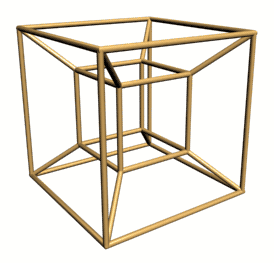
We can see a three-dimensional image of a tesseract, but we know that the tesseract is not three-dimensional. We are able to see the tesseract because what we see is a reduced reality, a limited version of the tesseract. We think we see a lot when we look at this projected image, but we do not see all the details and the entire shape how it really should be. This is because the cube has been drawn on a medium that allows less possible ways to draw/construct the object than in the (fictional) four-dimensional environment. So in some ways it is possible to draw an object that is supposed to exist in more than three dimensions, and we can look at that object and recognize that object to at least some degree.
(It gets even trickier than that. The image you see above is what you see on your computer screen, which is two dimensional, not three. The image has actually been projected twice, once from 4 dimensions to 3, to create the tesseract, and then from 3 to 2 dimensions, so that it can be shown on your screen. So it's a 3D representation of a 4D object on a 2D screen).
Our visual universe is in some ways similar to this projected tesseract. It too is a projected reality, a reduced visual image within a medium that is more extensive than we once thought it to be. But the projection method that shapes our visual perception of the universe that we live in is not like the projection method used for the tesseract. There are many ways that a high dimensional shape can be projected to a lower dimensional version of itself, and the way that the universe around us is being projected by our eyes is still for a great part unknown. Yet, right now there are a few basic things that can be told about the way that this projection works.
Method of projection
Most that is being projected is intangible for us, and most can not be detected with our other four senses either (sight, hearing, taste or smell). Most of it comes from outside of our own physical universe. For now lets call this region the 'non-physical universe', which is a larger part of the entire universe. All there is outside the physical part of our universe, within this non-physical part of the universe, is a field, a field in which waves propagate. The only source of the projection is this field. So all that is being projected is this field and the waves within the field. There are no objects or particles floating around in this non-physical realm. This projection of the field onto our physical universe is what creates the effect that some of that projected field is perceived by us as matter. Everything that we can see or feel is formed by projected field. But there is also some of the field being projected onto our physical universe that remains intangible for us (but often can be detected by other means).
NON-PHYSICAL UNIVERSE = ALL THE MULTIDIMENSIONAL SPACE THAT IS LOCATED OUTSIDE THE PHYSICAL PART OF OUR UNIVERSE, WHICH IS OUTSIDE THE RANGE OF THAT WHICH WE ARE ABLE TO FEEL, SEE, HEAR, TASTE OR SMELL
When there's a wave in the field, in a region that is being projected onto our physical universe, then that wave-projection causes a vortex to appear within our physical universe (a vortex as it is defined by the infinity-theory, not by its former meaning). When there's no wave in that region of the field, then that field can still be projected onto our physical universe, but such a projection will not form a vortex, such a projection can for example form a homogeneous fluid. It is for this reason that many antennas have a recognizable vortex shape (spiral antennas, helical antennas). To be able to catch a wave within our physical world we create a vortex that has the same shape as that which would result from the projection of that specific type of wave.
The number of dimensions that are present in the non-physical realm is not four, like with the tesseract. Nor is it five or six. The number of dimensions is much higher than that. The number of dimensions is most likely to be infinite. But not all these dimensions are projected simultaneously onto our physical universe. And not all matter within our physical universe is the result of a projection of the same number of dimensions. Some matter is the result of a large number of dimensions being projected onto a small volume in our universe (high dimensional), while other matter is the result of a small number of dimensions being projected onto a large volume in our universe (low dimensional).
One of the factors that determines how much is projected onto what size of volume within the physical part of our universe, is the angle of projection, which is the angle between the direction of the projection and the volume that is our physical universe. We can not see this angle, we can not see the path of projection, because this lies outside the physical part of our universe, part of dimensional space that we are not able to see in our three-dimensional universe. When the path of projection makes a small angle with the physical part of our universe, then the matter formed by the projection is called 'low dimensional'. When the path of projection makes a large angle with the physical part of our universe, then the matter formed by the projection is called 'high dimensional'. Both forms of matter behave in a characteristically different way.
One could ask how it is possible something could make an angle with the physical part of our universe, while our universe itself is three-dimensional. The reason for this is that there are many more than three dimensions outside our physical universe, so a line or a plane can make an angle with a volume, or even two volumes can make an angle with one another.
Many things are still unknown about the projection method. Some things that we do know or suspect will be discussed on pages to come. One thing to be said is that the number of dimensions that are included in a projection does not simply involve the number of axes (that could have been possible in the Cartesian coordinate system). Increase or decrease in angle of projection doesn't mean that one or more axes are spontaneously included or omitted from the projection. There's a gradual increase or decrease in dimension levels that reveals that there must be a different mechanism to this. And there are clues that suggest that a mathematical understanding of the field should involve the use of imaginary numbers, which is strongly suggested by a mathematical object called the Hopf fibration, which shows a strong resemblance with a toroidal type of vortex and hidden lines of movement that are present within all vortex types (this will be shown later).
To try to explain all this in a way that it's simple to understand, I use a visual model that shows how the projection works in a simplified way. It actually is the simplest way that I could think of for explaining wave projection. This model is called model #1, later I will show you model #2, which shall aid in explaining things a bit more further.
Explaining field projection with model #1
For the first model, we temporarily assume that this field with an infinite number of dimensions has only three dimensions, which is the highest number of dimensions that we humans have no trouble understanding. And we temporarily assume that our visible physical universe has not three dimensions, but instead only two dimensions. Think of the entire universe with the non-physical (and invisible) realm as the volume of a big cube. And think of our visible universe as the surface of a plane that lies within that cube. We humans appear to live, walk and breathe on the surface of that plane, but in reality the universe is bigger, because we can not see the rest of the volume that lies within the big cube.
Below are a series of steps that describe how the field projection works. Keep in mind that this method of explaining is overly simplified. It only offers a big picture of how the projection works. Many characteristics are not described with this method.
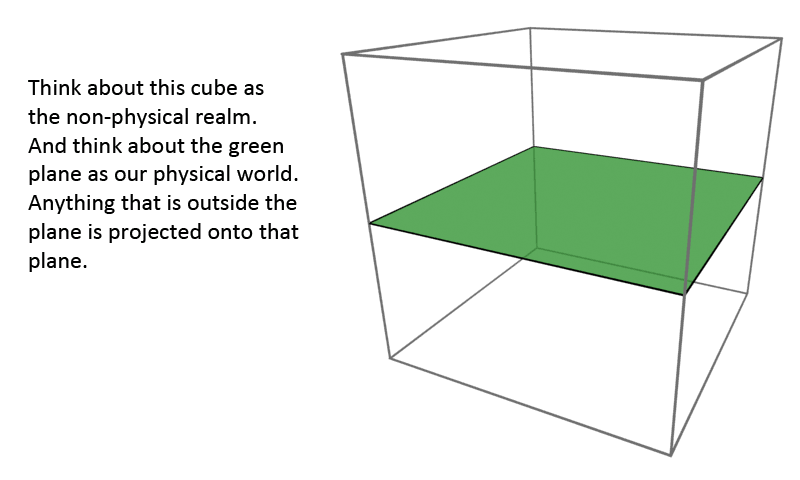
(We can leave out the cube from the model in the image above and assume that the universe is 3D and infinite in size. I only make the universe look like a cube because I find it easier to explain this way).
Many waves, like radio waves, travel within the volume of the cube, but out of reach of the plane. So we can not see them, or feel them, but they do exist in the universe around us. They do sometimes appear to move through us, but in fact they do not, because we are on the plane and the waves are outside the plane, in a different location within the cube. We think that the waves move through us because of the way that the projection method makes us believe that those waves are crossing the same space.
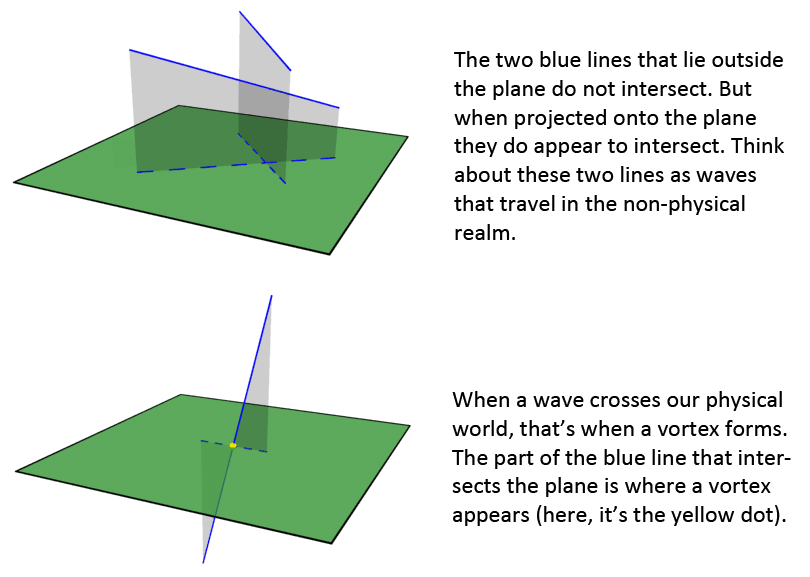
So when a wave that travels through the non-physical universe crosses our physical universe / physical plane, a vortex forms at that crossing point. We can not see the wave, we only see the vortex (but not always). But the size and shape of the vortex that forms within our physical universe gives us information about the nature of the wave.
For instance, if we can identify the shape of the vortex and determine its type, we can determine how high or low dimensional the wave is. Thus we can determine whether the wave makes a low or high angle with our physical plane. This gives us information about several properties of the wave and the nature of how it behaves. One of these properties is how fast the wave travels, which is a direct result of the angle of projection.
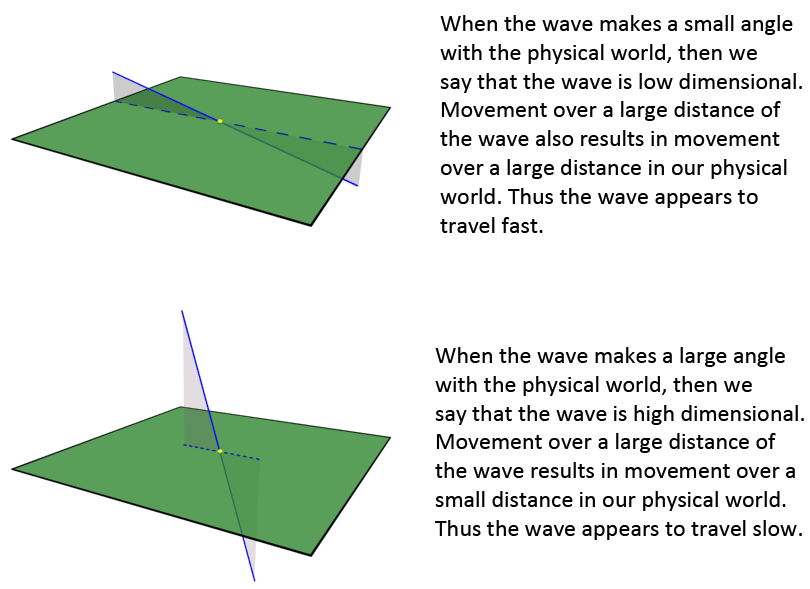
The vortex at the location where the wave passes the physical plane always has a shape that is directly related to the angle of projection. If the angle of projection changes to a higher angle then the shape of the vortex also changes. Every vortex has a unique shape, which makes it possible for us to identify its type. Only some vortex types look almost similar, but their direction of movement (how the vortex flows) is different.
There are multiple vortices that have either a spiral or helical shape in them. In nature we can also find many spiral and helical shapes. These shapes are also a result of the projection method that is used, the projection method that casts the wave field and its waves onto our world.
As a result of this projection method, there are a couple of special cases where the distinction between a wave and a vortex differentiates from the other cases. For instance, it is possible that the entire wave lies within our physical plane. In that case the entire wave becomes the vortex, or the vortex becomes the wave (best to be said is that the vortex = the wave). Such a vortex-wave is what we experience in our world as visible light. Because of the parallel orientation of the wave to our world, these waves also travel the fastest.
And then there's the special case where the angle of the wave with our physical plane is exactly 90 degrees. When such a wave is projected onto our world, we observe no wave around the vortex, and the vortex itself is a line (closed circuit) that does not have any volume, thus we don't see a vortex at all. But we can still feel the vortex when its strong enough and we can displace the vortex within our physical world. Such a vortex is what we experience as electricity. The wave is still present, but doesn't radiate outward nor does it appear to have volume. It can appear to remain motionless, but in reality it is constantly moving 90 degrees upward or downward within the non-physical universe as is what we call an 'electric current'.

Light has a very low projection angle thus is a very low dimensional vortex. Electricity has a very high projection angle, thus is a very high dimensional vortex. In between these two extremities, which we call EM crossing locations, are 11 dimension levels on which each of these can exist unique vortices (actually there are 12 levels, 11 full levels and two half levels). Although light is a very low dimensional vortex, it is not the lowest dimensional that exists. And although electricity is a very high dimensional vortex, it is still not the highest dimensional. But these two special cases are transitional locations within the total sequence.
Although these vortices come from waves that travel over the non-physical part of our universe straight through our physical part of the universe, they do not allow matter to be pushed out of our physical part of the universe. Its a good thing for me to say that now before someone starts thinking about wormholes or about visiting another universe. As far as I know, such movement is not possible. Large vortices like our own galaxy do however influence how we travel within our own physical universe. Much can be said about that, not about wormholes.
The projection method is also the reason why objects in our visible universe can appear to be separate objects. But as you might understand by now, the wave and the vortex are part of the same movement, they both are made of, and exist, within the same field. The field itself does not show any segregations, and there are no two fields. The field itself is one continuous volume with an infinite number of dimensions. It is quite possible that this projected field is the only fundamental substance that exists, from which all other phenomena are created. If we consider this field to be the building stone of our universe, then all that we know of to exist is connected to one another.
One of the problems with model #1 is that waves here are described as lines. This is not satisfactory because most waves do not travel in a straight line. A better representation would be one with a movement whose shape is more outward and spherical. Because of this I need to explain things a bit less simplified, for this I came up with model #2, which is not described on this page but on another page further ahead (the page is called 'Waves and Projection').
How do we name this field?
So there's a field that fills up all the space in our universe. And up until now we have not mentioned a name for that field. There are already numerous theories about a universal wave-field, the most common used name for this is 'ether' or 'aether'. It is a possible word for me to use for this wave-field, but it is a word that also refers to a few other theories, which can be both classical or modern theories, that do not show many similarities with the infinity theory. But still there are many sources give the word aether the same general meaning as in the infinity theory, which is one universal medium over which all waves travel. For now I have decided to use a new name for this field, which is 'the onefield'.
THE ONEFIELD = WAVE-FIELD WITH AN INFINITE NUMBER OF DIMENSIONS WHICH FILLS UP THE SPACE IN THE ENTIRE UNIVERSE
I hope that people who support one or more modern aether theories do not feel that it is unrighteous that I have chosen a new name for the universal wave-field. Many people around the world share a strong believe that there is a single medium in which waves propagate. By coming up with a new word for this medium, it almost seems like I dissociate myself from acknowledging their efforts or that I claim that this idea about one single medium is my own idea, while in fact, this idea has been living around for a long time, and has been kept alive by many. But those people who support a modern aether theory need to keep in mind that there have been many aether theories over the course of many years that have lost ground because their claims have been disproved by modern science. If a new theory emerges that can win more ground through the evidence provided by new radical discoveries, then the use of the word aether might feel like an insult to the science community that was able to disprove prior classical aether theories. We should be focused at uniting different people from different backgrounds who have a different way of looking at the universe so that we can create a new general consensus in science, and not to create barriers of conflict in our ways that we describe the knowledge that we encounter.
In summary, we can now write down these following definitions of phenomena that are closely associated with the onefield:
| Physical Universe | The three-dimensional 'perceptual screen' onto which some parts of the onefield are continuously being projected thereby forming all that which we humans perceive through our senses |
| Non-Physical Universe | All the multi-dimensional space that is located outside the physical part of our universe, which is outside the range of that which we are able to feel, see, hear, taste or smell |
| The onefield | The multi-dimensional wave-field, with an infinite number of dimensions, that fills the entire universe |
| Projected Wave | A wave that travels over the onefield, projected onto the physical part of our universe |
| Vortex | The part of a wave in the onefield that intersects the physical part of our universe |
| True Universe | The universe that we humans choose to believe is real. Either the three dimensional (which only reveals a limited range of dimensions), the infinite dimensional (that includes all dimensions but of which most lies outside the range of our senses) or both. |
There could be waves within the onefield that are not projected onto our world. This is likely because only a selective part of the onefield is projected. But because they are not projected, and because we have no information about them, we will ignore that possibility for now and only focus on the waves that are projected. In time, if we get to learn something about them, we will focus on those waves too.
What is also not known is if the onefield fills up the entire non-physical part of the universe. We are not sure if there's something more than just the wave-field. Because also this information is lacking, we assume for now that it's the only building stone that exists outside the physical part of the universe.
The unknown coordinate system
Most of us already know how dimensions work in the Cartesian coordinate system, which is not difficult to understand. It is the coordinate system that we all learned at school. 1D, 2D and 3D stand for the number of axes that we are working with. Every axis introduces two new directions of movement. We could say that that the x-axis gives us left and right movement, the y-axis gives us up and down movement and the z-axis gives forward and backward movement. Any movement can be a combination of these movements. We can not simply use this system all throughout this website to show how the dimensions of the medium of the onefield works, for simple reasons.
That reason is that all that we observe is a result of a projection. What we observe all appears to be 3D. The number of dimensions of the onefield is infinite, but only a limited number of dimensions is projected onto any given location in the physical part of our universe. And these projected number of dimensions do not limit themselves to whole numbers, but can be any value in between. So it can be that not two dimensions or three dimensions are projected onto the physical part of our universe, but 2.5 or 3.25, fractions in between. This is not because these partial dimensions really exist as partial dimensions but because only these fractions are included in the projection. These dimensions exist as a whole, thus without fractions, within the non-physical part of our universe. But of some of these dimensions only a fraction is revealed to us. Plus there is more that is different from the Cartesian system, because this value can also be negative. The angle of projection can be lower than 0 degrees, thereby making a transition to yet another new region of the sequence, with different characteristics.

The values of this new unit is expressed in dimension levels. When comparing the onefield system with the Cartesian system, then two dimension levels in the onefield system equals one full axis in the Cartesian system. For converting the dimension levels of the onefield to Cartesian dimensions based on axes you would only need to divide the number by 2. Thus 6 dimension levels = 3D. It is quite possible that this is because each dimension level in the onefield system equals one axial direction, combining two opposite directions to form one full axis. Or it could be that one dimension level is the foundation for an axial movement in space and the other dimension level is the foundation for a rotational movement in space.
I need to assure everyone who is reading this that this new terminology is not fixed. It is still subject to change. I am not the only one who is going to decide how this or that is going to be named. In time more people will cast their vote on how things should properly be named. The names might also change as we learn more and know more about all that relates to the infinity theory. But for now this new terminology is required for me to work with, and is simple and sufficient.
Dimensionality is a word that already existed before this theory came to life, but here it is used in a way that the word more or less becomes a new word, one that builds on its former meaning, but refers to a new coordinate system.
Is our 3D perception of the universe real?
This website will explain to you, without many technical words or any pre-required level of knowledge, that all that we see is projected field. And that every object that we see is composed of this projected field. Many shapes that we experience in the world around us are created by the movement of vortices. These vortices are created by the waves that appear within that field and cross our physical universe.
This brings us to the final question: which universe is real? The non-physical universe, or the physical universe? Theoretically speaking, is the tesseract (4D hypercube) real? Or the 3D representation of the tesseract? Is the image real before it has been projected, or after it has been projected? Or do we consider both these universes to be real?
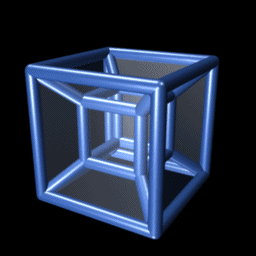 |
 |
 |
| animation by Jason Hise |
video by T.T.Lim, University of Melbourne. Movie was cropped and converted to GIF anim |
animation by Paul Nylander |
| rotating tesseract | leap-frogging vortex rings | leap-frogging vortex rings |
From our own perspective it has always seemed that the 3D universe is real. Anything else is more difficult for us to imagine to be real. Even more so because we can not see the real representation of that other universe. It are our own senses that make us see a 3D universe. And there's a good chance that there are other life-forms, within our universe, or even on our own planet, that do not see the equal number of dimensions that we do. For them the number could be higher or lower than three. Perhaps some life-forms can see or sense all the dimensions altogether.
The debate of which of the two universes is real can go on for a long time. I myself believe that the universe that we experience is real. Everything we perceive does exist. But it is our perception of what we experience that is not always in its full form. Some things are hidden away from us, perhaps for good intentions. It could very well be that we will learn how to explore that which is now hidden away. For now I will give you what I think is the best possible answer to this question. But each person needs to explore for himself what his/her opinion is.
THERE IS NO SUCH THING AS A THREE-DIMENSIONAL UNIVERSE. THERE IS ONLY A THREE-DIMENSIONAL PERCEPTION OF THE UNIVERSE, EXPERIENCED BY SOME LIFEFORMS
| All content on this site that is authored by Peter.A.Venis is licensed under the Creative Commons CC BY 4.0 license, unless otherwise mentioned. Most pages on this website also include material from other authors, under different licenses. Both the author's names and the licenses are mentioned in the file names whenever this information is known and can be provided. The presence of work from other authors on this website does not necessarily imply that those authors endorse the contents of this website. |
| A word that is often used on this website is the word 'vortex'. Many sources describe a vortex as a movement in a fluid that has a rotational flow. Yet many of the vortices that I describe on this website do not show a visible rotational flow. I took the liberty of using the word vortex for describing a phenomenon that had not been understood before, one that links together rotational and non-rotational movements. Even a movement in a straight line can in some cases be categorized as a vortex, if it is known that that movement is created by certain identical conditions. So keep in mind that the word 'vortex', within the context of the infinity-theory, has not the exact same meaning as other sources describe. |




